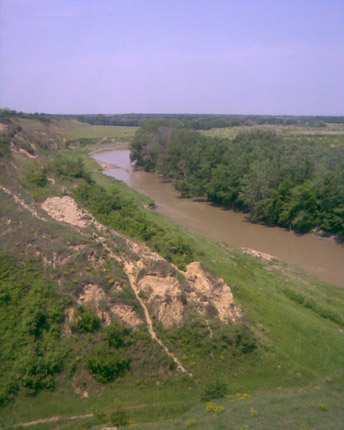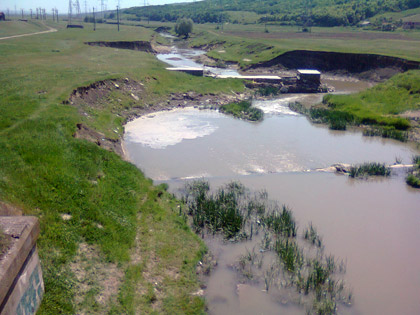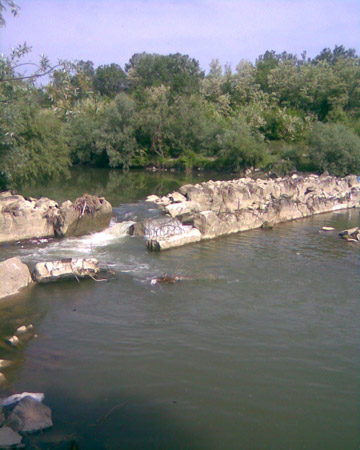Restoring Aquatic Ecosystems Bioengineering & Ecotechnology
Natural rivers and their floodplains are among the most complex and diverse ecosystems in the world. Rivers have been used for hundreds of years for food, water, irrigation, electricity generation, transport, discharge of pollutants, tourism and recreation. The problem is that, historically, these activities have been accomplished without properly considering ecosystems’ environmental and conservation features.
Rivers and their adjacent wetlands have the following natural features:
- Habitat for fish, which offers optimal conditions for their reproduction;
- Habitat for birds, mammals, amphibians, reptiles and various invertebrate fauna;
- Water storage and sediment retention;
- Water self-purification by storing and recycling nutrients and by transforming organic and inorganic pollutants;
- Biodiversity – hardwood floodplain forests are highly productive;
- Economic and social benefits: water source, transportation, building materials, eco-tourism, recreation and education.
When restoring rivers, the starting point is represented by a precise knowledge of all abiotic and biotic components of the area, such as climate conditions, hydrological regime, knowledge about silt and substratum structure, flora and fauna, intensity of erosion processes, water and sediment chemistry, etc. These components must be taken into account when proposing the ecotechnical solutions described below.
The problem of watercourse ecological recovery is a matter of public interest and water management. These issues and their resultant degradation are a byproduct of human impact caused by factors that include industrialization, urbanization, livestock and agricultural development, exploitation of materials in riverbeds, regulation and embankment works. Within sectors requiring restoration, the activities created to recover the ecological balance and to recreate the affected areas will follow a system that becomes autonomous.
Ecological recovery refers to both the water itself and its surrounding areas, such as watercourse banks, floodable plains, etc., which are of major importance in the development of flora and fauna. The process of ecological restoration and recovery consists of the development of natural or man-driven processes aimed at eliminating the negative consequences of regressive ecological processes (worsening structural and functional ecosystem conditions as a byproduct of negative, natural or anthropogenic impacts) and also of ecosystem recovery now degraded.
Ecological recovery or restoration has the following forms (S. Godeanu, 1998):

Photo Courtesy of Razvan Voicu | The right bank of Ialomiţa River in Romania, near Bueşti Village, with strong erosion.
1. Natural Regeneration – an ecological recovery process whose development occurs without human intervention, if the development takes place in normal and natural conditions of recovery of an ecosystem structures and functions affected by natural or anthropogenic causes. If there is no human intervention in this process, then this is termed “ecological recovery.”
2. Ecological Rehabilitation – the process of re-creation or recovery of the ecosystem following an ecological regression where experts manage the recovery process according to the original form structures and functions previously possessed by the given ecosystem or group of ecosystems.
3. Ecological Restoration – the reconstruction process of a new type of ecosystem after destruction and/or other ecological regression. Part of the old ecosystem is contained by the new structure (climate factors, soil factors), but the biological component is largely different from that found previously. The focus is more on functionality than on ecological restoration of previously existing structures.
4. Environmental Remediation – the process of “healing” ecological systems seriously affected by natural or anthropogenic impacts by deliberately using a complex of physical, chemical and biological means. For example, it can be applied to combat lake eutrophication by removal of toxic substances from the environment to restore lands.
5. Ecological Construction – the process of creating artificial ecosystems in the human habitat. This is made either to increase human comfort or for intensive food production.
Ecotechnology is defined as the use of technological means for ecosystem management based on a deep understanding of the principles on which natural ecological systems are built and on the transfer of such principles into ecosystem management in a way to minimize the costs of the measures and their harm to the global environment (Uhlmann, 1983, Straskraba, 1986, 1993, 1996).
Below are the environmental activities belonging to ecotechnology:
- Maintenance of natural ecosystems in normal operating conditions;
- Environmental management of ecosystems under human control;
- Prevention and control of environmental degradation, environmental management of human settlements and artificial ecosystems;
- Assessment and measures in order to block global changes.
Ecotechnology has two branches (S.Godeanu 1999):
1. Environmental Engineering – This process deals with human influence on the environment during production processes. It deals with formed systems functioning for long periods due to specific interaction between society and its complex work (in cities, industry and agriculture). And, it supervises the action of the resulting products on the environment (Mitsch & Jorgensen, 1989 and Ivanov, 1989).
2. Ecotechnology Itself – This includes all technical papers based on ecological concepts translated into technical means. Ecotechnology identifies those ecosystems that are more responsive to human needs. It starts from the concept that humanity’s and nature’s interests are inseparable because humans are part of nature. Furthermore, the human being is not able to develop if he/she does not care of the whole environment (in all its complexity). Therefore, the more human beings manage to take care of the environment, the greater likelihood that the sustainable development of human society will be ensured in the long run. For these reasons, measures taken need to rely directly on a deep ecological knowledge of the situation at a certain moment and on a future perspective. Ecotechnology achieves the common goal of human society and natural environment to gain benefit for both parties.
Ecotechnology considers the environment as a single, integrated, living/non-living system in which man optimizes the natural processes of self-arrangement and of the environment’s acceptance regarding the introduction of new species chosen by man. Ecotechnology’s main concepts are based on environmental factors.

Photo Courtesy of Razvan Voicu | Bârlad River in Romania, near Vaslui City, with strong erosion.
The basic unit is the ecosystem, and it has the advantage of being achieved at low costs and with important long-term effects. Relative to certain situations, ecotechnology handles physical, chemical or biological factors in order to better operate within an integrated system. Man becomes a factor that facilitates the development of processes within ecosystems, thus leaving nature to do what is most important (Godeanu, 1998).
According to Straskraba (1996), ecotechnology is guided by the following principles:
- Energy inputs to the ecosystems and available storage of matter are limited. Any ecological system requires a limited amount of energy consumed during the maintenance process. The excess of this energy can be stored as matter for longer or shorter periods; the degree of storage is limited in terms of the necessary substance in circulation. According to some surveys, 90 percent of the substance is stored and only 10 percent is in circulation globally (Soran & Borcea, 1985). The storage methods are various and start from fossil products to humus, as sediments, or as forms of resistance in plants and/or animals.
- The information of ecological systems is stored in its biotic or abiotic structures. The more information a system contains, the greater is its stability and the longer is its life and climax periods. Within ecological systems, living and non-living factors interact in order to maintain as much information as possible. Consequently, when disturbing factors or pollution intervene (that is poor or lacking information matter), the system’s information may be adversely affected.
- The ecological systems are open, dissipative. They are dependent on energy inputs. It is only partially converted to bioproducts, the rest being lost by entropy. Simultaneously, some parts of bioproducts are subject to degradation. In the course of time, new bioproducts, which provide a permanent movement of substances, appear – all taking place during uninterrupted energy inputs that in turn dissipate through multiple ways.
- Ecological systems are systems with mediated multiple feedback. Any changes, no matter how small and wherever they occur in the system, can cause various effects in surprising places. Self-regulating systems are able to reduce the maximum effects.
- Ecosystems have homeostasis of high capacity. Due to this ability, the ecological systems are stable. The environment acts on ecological systems trying to disturb them. When inputs are particularly intense homeostasis may weaken, especially when disturbing factors exceed certain limits, and the system may collapse.
- Ecosystems are self-organizing adaptive systems. According to this concept, the inputs manifested on them can be – within certain limits – corrected, thus allowing adaptation to new environmental conditions by self-organization.
The ecotechnical methods presented above can now be performed anywhere and can help restore river beds as well as migratory species of fish from various rivers on Earth. These methods have been developed according to the protection norms of aquatic ecosystems. It should be noted that the ecotechnical solutions proposed in this paper are designed to improve the quality of rivers that are and will be under study, and are expected to complement measures regarding reduction of pollution at the source, which has an impact on these rivers (discharge of untreated/poorly treated wastewater). Such measures are considered mandatory before any solutions for ecological rehabilitation/reconstruction of aquatic ecosystems can be performed.
Beneficial eco-hydrological effects that can be obtained from application of these solutions include:
- Erosion control by regulating sediment transport and distribution,
- Stabilizing banks through the root system of vegetation,
- Improving water quality by bioconversion and bioaccumulation,
- Production of organic matter for aquatic ecosystems and providing habitat for flora & fauna, and
- Riparian forest development on these sectors, which will provide shelter for many bird species.

Photo Courtesy of Razvan Voicu | Ialomiţa River at the confluence with Prahova River, near Dridu Village, downstream Dridu Lake.
Wetlands are an important habitat for invertebrates, fish, waterfowl and for many species of plants. They contribute to maintaining water quality, filtering pollutants, retaining sediment material, oxygenating water by rich vegetation, absorbing nutrients (nitrogen, phosphorus, etc.) or recycling them, regulating the microclimate, helping to prevent flooding and erosion, recharging aquifers, facilitating water supply and advantageously replacing some hydraulic structures built at great expense.
Riparian areas are ecologically important because they perform certain critical functions. These include providing erosion control by regulating transport and distribution of sediments, improving water quality, producing organic matter for aquatic habitats and providing wild habitat for flora and fauna, removing excess nutrients and other contaminants, adjusting fluctuations in water temperature and maintaining recharge and base flow of groundwater towards the rivers, and stabilizing banks while having efficient control of floods in this area.




























